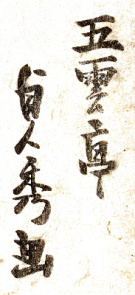Sadahide (1807-1873)
Sadahide Utagawa, originally Kenjiro Hashimoto, was a versatile and influential ukiyo-e printmaker from the nineteenth century, also known under the pseudonymns Gountei, Gyokuo, Gyokuran, Gyokuransai, and Gyokurantei. Born in 1807, Sadanobu was a distinguished pupil of Kunisada and operated primarily in Edo and later in Yokohama following its opening to the West. His works encompass a wide range of subjects, from traditional Japanese scenes and theatrical prints in the Osaka style to innovative depictions of contemporary industrial scenes and foreign visitors, which emerged after the pivotal Convention of Kanagawa in 1854 and the subsequent Ansei Treaties.
Sadahide was at the forefront of integrating Western artistic techniques into Japanese printmaking, evident in his use of perspective and detailed studies from a bird’s-eye view. His yokohama-e prints, produced during a period of significant cultural and economic transition in Japan, depicted Westerners and their technologies with a keen eye for detail and curiosity, capturing the essence of a rapidly globalising Japanese society. These prints, along with his political cartoons and reproductions of earlier masterworks, highlighted his adaptability and breadth as an artist. In recognition of his contributions, Sadahide was one of eleven Japanese artists to exhibit at the Paris International Exposition of 1867, where he was honoured with the Légion d’Honneur, marking a significant achievement in his illustrious career.
The first exhibition dedicated solely to Sadahide's work was held in 1997, subtitled "The ukiyo-e artist who flies in the sky," celebrating his pioneering use of aerial perspectives and his imaginative approach to the evolving world around him. This exhibition shed further light on his unique position within the ukiyo-e tradition, demonstrating his enduring influence on the genre.
 |
 |
 |
Signatures from left to right: Gyokuransai Sadahide ga, Gountei Sadahide ga, Gyokuransai

